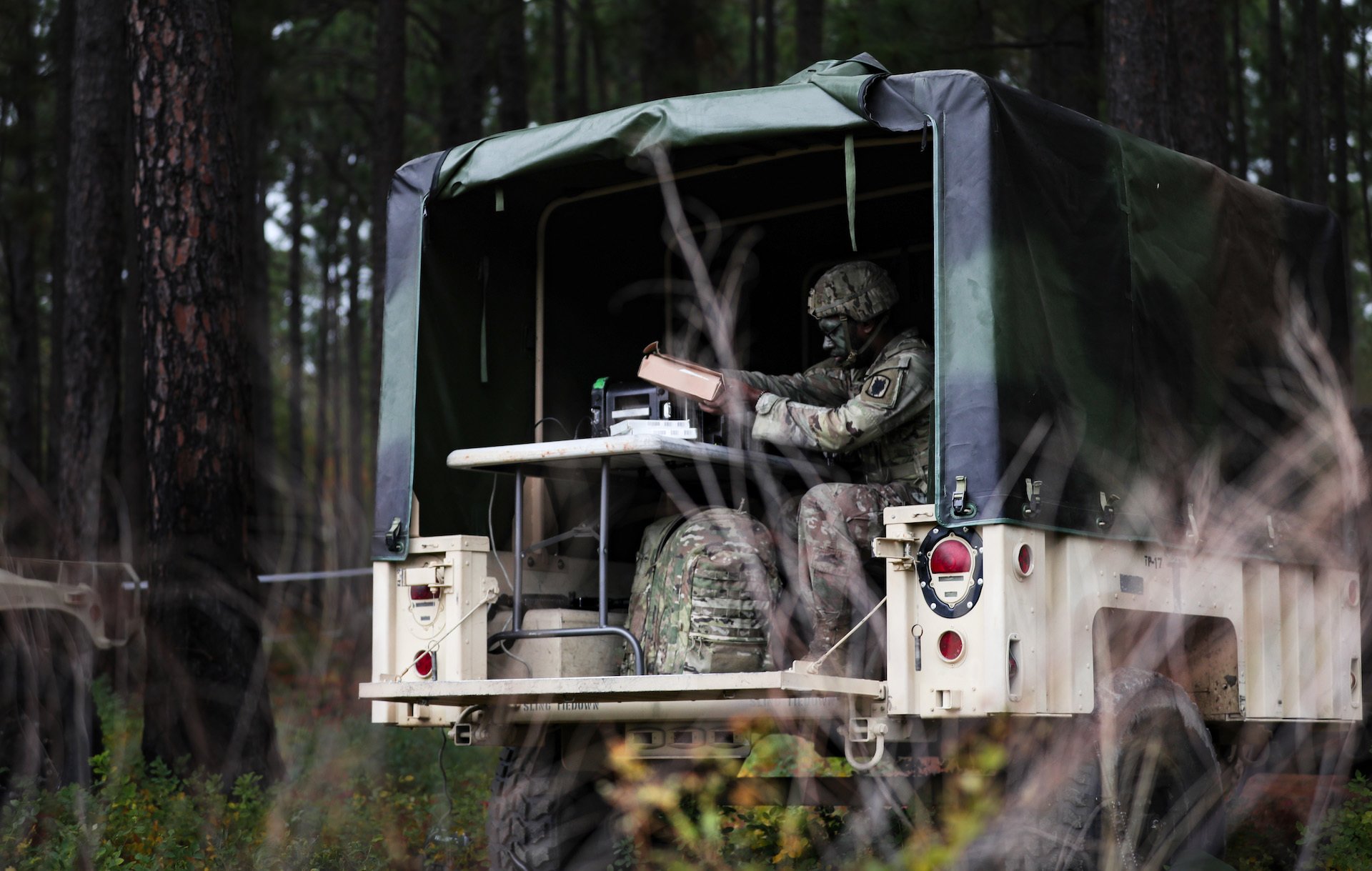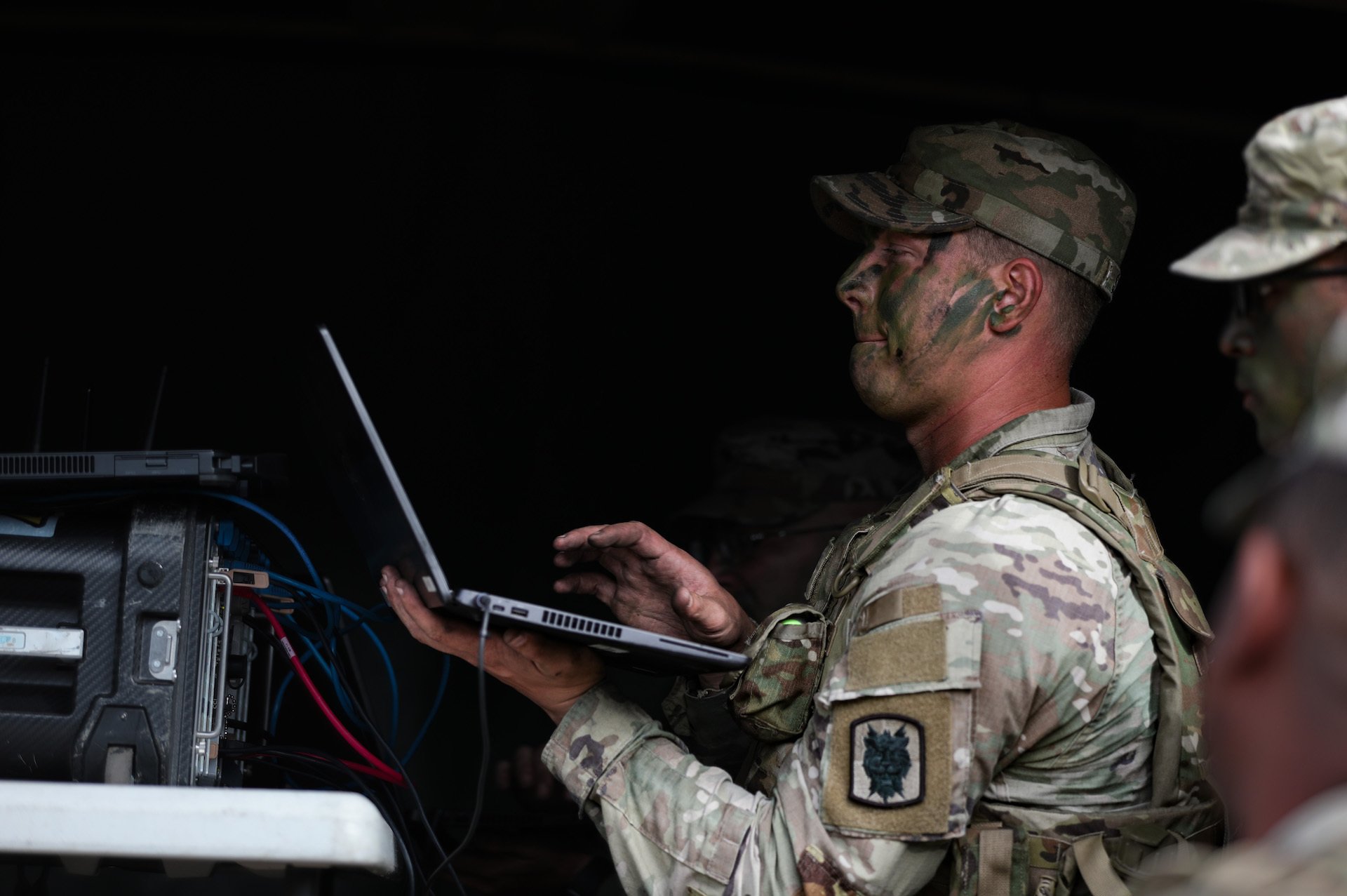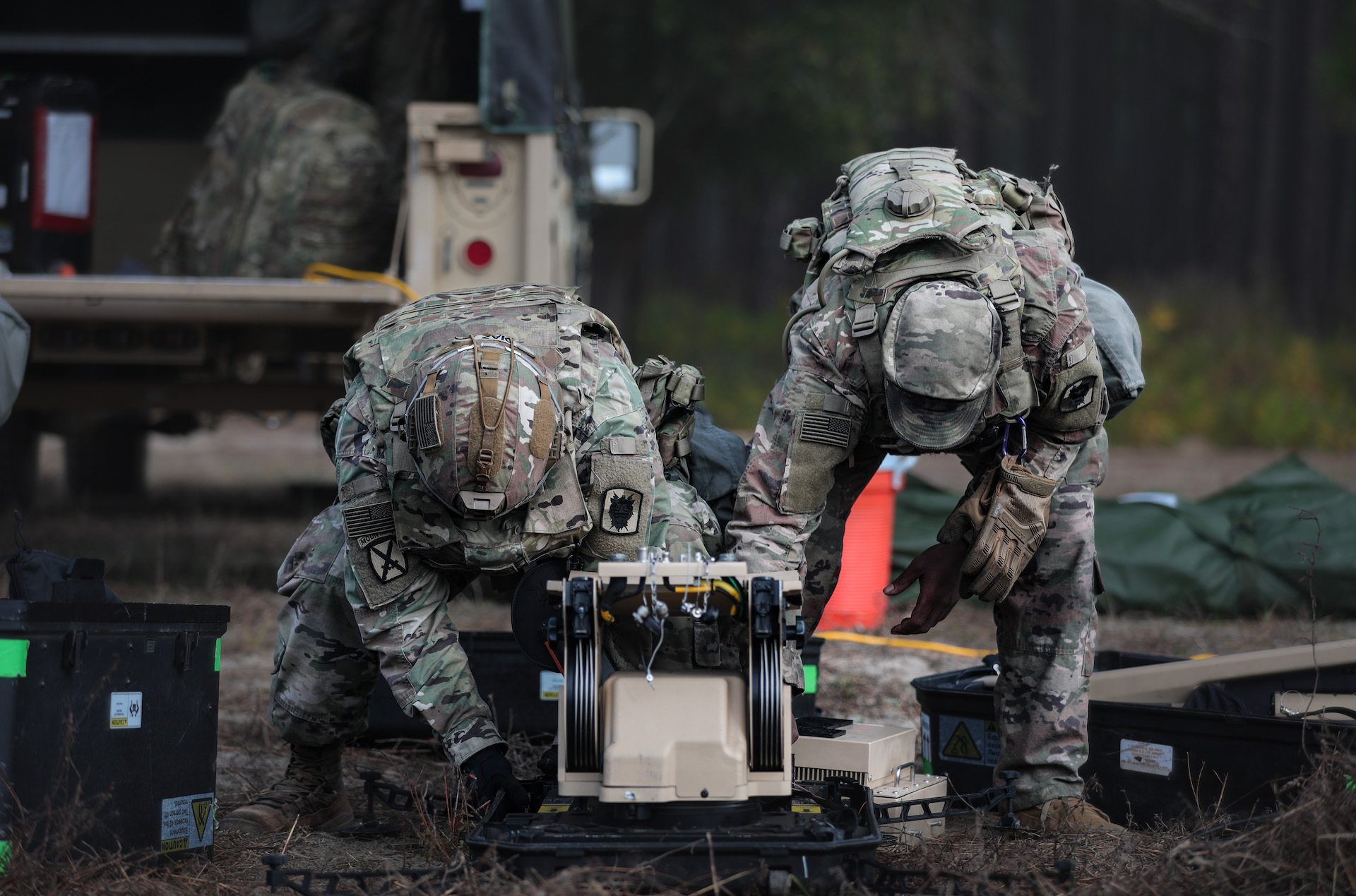They’re Trained To Be ‘Verizon for the Army’ — But First, They Have To Pass This Test

Soldiers from the 50th Expeditionary Signal Battalion-Enhanced (ESB-E), 35th Corps Signal Brigade, set up their equipment during a field training exercise on Oct. 26, 2022, at Fort Bragg, N.C. The 50th ESB-E spent a week in the field, running through day and night validation exercises where each crew had to complete a time digital gunnery table to certify their scalable network nodes. (U.S. army Photos by Sgt. Maxine Baen)
FORT BRAGG, N.C. — Four soldiers exited a Humvee, pulled three suitcase-sized trunks from a trailer, and began unboxing pieces of a satellite dish. Evaluators stood nearby, grading their every move, just after 9 a.m. on Wednesday, Oct. 26.
The soldiers from the 50th Expeditionary Signal Battalion-Enhanced, stationed at Fort Bragg, raced a one-hour clock, but their straight faces and quiet communication masked any anxiety.
Signal units think of themselves, as one soldier put it, “like Verizon or AT&T for the Army.” Infantry attacks targets. Artillery fires cannons. Armor drives tanks. But for all those soldiers to communicate on the battlefield, Signal has to come through with clear, unbroken comms.
The team’s leader, Cpl. Shamek Singleton, directed the soldiers as they pulled out and started a red Honda generator that would power their makeshift command post. “We’re doing our validation just to make sure all of our equipment comes up, everything works properly, so when we do go downrange, there’s no stuttering, no issues,” Singleton told Coffee or Die Magazine. “Everybody’s tracking what they need to do and how to get it done efficiently.”

Soldiers from the 50th Expeditionary Signal Battalion-Enhanced (ESB-E), 35th Corps Signal Brigade, set up their equipment during a field training exercise on Oct. 26, 2022, at Fort Bragg, N.C. The 50th ESB-E spent a week in the field, running through day and night validation exercises where each crew had to complete a time digital gunnery table to certify their scalable network nodes. (U.S. army Photos by Sgt. Maxine Baen)
The war in Ukraine has, in many ways, been won and lost around communications. Russia disabled much of Ukraine’s communications infrastructure early in the war, just after invading in late February. However, the Ukrainian military has relied on Starlink — the private satellite communication network launched by Elon Musk — to link commanders and troops on the front lines.
The 50th's evaluation didn’t test the soldiers on Starlink, though its commander, Lt. Col. Merlin Kynaston, said the unit has experimented with carrying the system. “Now I can pull up cellular, Starlink, MIL-SAT,” Kynaston said. “What I’ve done is I’ve diversified communications so that, if an enemy wants to stop it, they can jam one, maybe they jam two. Transportation diversity is a big thing to me.”
The 50th Expeditionary Signal Battalion-Enhanced, or ESB-E, became the Army’s first “enhanced” battalion in 2021, with smaller, lighter, and higher tech equipment. To set up the networks and communications that once required several large trucks, a team from the 50th like Singleton's can deliver with a Humvee and a trailer.
Singleton and his team were part of the 50th’s certification for Charlie Company to support the Immediate Response Force, or IRF, which includes 82nd Airborne Division paratroopers. The 82nd maintains a brigade combat team ready to deploy anywhere in the world with 18 hours’ notice. The field test would qualify the 50th to deploy in support of that force.

“When the call comes down, and they need someone out there, we’re able to efficiently pack our stuff and head out there and provide that first-man-down communication,” Singleton said.
Despite the test’s time limit, the crew of four signaleers didn’t run to accomplish tasks, but worked methodically. Within minutes, the squad had set up a 7-foot-wide office in the trailer, including a table with laptops and cords, all powered by the portable generator. Then, the signaleers began assembling a 4-foot-wide Hawkeye satellite dish.
Nearby, two other teams from Charlie Company did the same. Throughout the day, a total of 14 teams from Charlie Company would race the clock to certify for duties with the IRF.

As "Verizon for the Army," signaleers set up communication networks across battlefields. US Army photo by Sgt. Maxine Baen.
Standards for the company about to assume IRF duties are more stringent than standards for other companies. “Normally, we have two hours to validate, but, today, we have an hour,” Singleton said.
Once the teams set up their equipment, they had to prove it worked. First, the team hopped onto local cell networks. Then, according to Staff Sgt. Sean Neely, an evaluator, the soldiers would have to connect to satellites about 22,000 miles above the equator in geosynchronous orbit.
The evaluation, Neely said, was like an expert marksmanship test, but for signaleers. The cell phone network was the easy part, he said, the satellite shot less so.
“They’ll come up on 4G really, really fast — 15 minutes. And then they’ll go, and they’ll get the satellite,” Neely said. With the dish, the soldiers were trying to beam to a tent-sized satellite with a signal the width of a pencil, he said.

“Sometimes it takes a long time,” Neely said. “Sometimes it’s very quick based on the database we build with repetition. That’s why practice is important, because the modem will save that database. The more things it recognizes in the sky — it’s like landmarks on the way to your grandma’s house. If you know where that thing is, then you can find your destination.”
Before the hour ended, the teams had to make phone calls and pull up websites via cellular service and satellite. Neely said that teams usually “bust time” when they can’t communicate with the satellite.
But this day, Singleton’s team nailed it.
“We kind of had to crunch it down, but we got it done,” Singleton said. “I believe it was around 45 minutes. It was pretty tight, but we got it done.”

Soldiers from the 50th Expeditionary Signal Battalion-Enhanced (ESB-E), 35th Corps Signal Brigade, set up their equipment during a field training exercise on Oct. 26, 2022, at Fort Bragg, N.C. The 50th ESB-E spent a week in the field, running through day and night validation exercises where each crew had to complete a time digital gunnery table to certify their scalable network nodes. (U.S. army Photos by Sgt. Maxine Baen)
After the daytime trial, the Charlie Company teams came back for a night evaluation. For that time trial, they had three hours.
Kynaston said that Army communications equipment wasn’t always so tiny and portable. ignaleers needed two vehicles to set up a node until a couple of years ago, he said. One vehicle towed a generator, and the other pulled a satellite dish about twice the size of the Hawkeye dish.
“That takes up a C-17,” Kynaston said.
The current dish, when disassembled and divided into three cases, fits in the overhead compartment of a commercial airplane. “I could easily get ahold of a crew-cab pickup truck and fit four people in and throw all the gear in the bed of the truck so that I can hide in plain sight,” Kynaston said.
According to the Army, the lighter loadout reduced transportation requirements by 60%. So far, the service had upgraded six Army signal units, including one from the National Guard, to “enhanced” battalions.
The time trials at Fort Bragg were part of a larger event — the first battalion field exercise since before the COVID-19 pandemic, starting on Oct. 24. “We set up our gear all the time,” Kynaston said. “Every Tuesday, we set up our gear, but we don’t set up in a tactical posture.”
The soldiers of 50th ESB-E’s Alpha and Bravo companies also participated in the field exercise throughout the week, Kynaston said. But only Charlie Company had to meet the stricter standard.
“What we don’t want is our soldiers to look in an admin posture when everyone else is in a tactical posture,” Kynaston said. “We’re getting after knowing what right looks like, doing it fast.”
Read Next: Sergeant Major of the Army Talks Recruiting (Down), Retention (Up), and the ‘W Word’ (Woke)

Jenna Biter is a staff writer at Coffee or Die Magazine. She has a master’s degree in national security and is a Russian language student. When she’s not writing, Jenna can be found reading classics, running, or learning new things, like the constellations in the night sky. Her husband is on active duty in the US military. Know a good story about national security or the military? Email Jenna.
BRCC and Bad Moon Print Press team up for an exclusive, limited-edition T-shirt design!
BRCC partners with Team Room Design for an exclusive T-shirt release!
Thirty Seconds Out has partnered with BRCC for an exclusive shirt design invoking the God of Winter.
Lucas O'Hara of Grizzly Forge has teamed up with BRCC for a badass, exclusive Shirt Club T-shirt design featuring his most popular knife and tiomahawk.
Coffee or Die sits down with one of the graphic designers behind Black Rifle Coffee's signature look and vibe.
Biden will award the Medal of Honor to a Vietnam War Army helicopter pilot who risked his life to save a reconnaissance team from almost certain death.
Ever wonder how much Jack Mandaville would f*ck sh*t up if he went back in time? The American Revolution didn't even see him coming.
A nearly 200-year-old West Point time capsule that at first appeared to yield little more than dust contains hidden treasure, the US Military Academy said.












